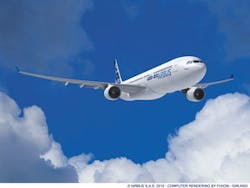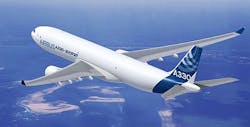US Airways receives Supplemental Type Certification for DO-260B capability on Airbus A330 aircraft using ACSS NextGen Mode S transponder
PHOENIX, 27 Sept. 2012. US Airways gained Supplemental Type Certification (STC) for DO-260B (TSO c166b), the highest level of Automatic Dependent Surveillance-Broadcast transmission (ADS-B Out) capability, on the airline’s Airbus A330 aircraft using the XS-950 Mode S transponder from ACSS, an L-3 Communications & Thales Company.
DO-260B enables ADS-B transmission of more information about an aircraft’s position, speed, and intent, as well as meets the upcoming mandate for the FAA’s NextGen airspace initiatives. The XS-950 advanced Mode S transponder from ACSS was certified to DO-260B readiness in 2011.
US Airways plans to equip 20 Airbus A330s with ADS-B as part of the FAA’s NextGen implementation program.
“US Airways and our other airline partners understand and embrace the opportunities and savings NextGen provides for operators,” says Terry Flaishans, general manager of ACSS. “Our investment in ADS-B avionics is helping airlines fly the most efficient routes to their destinations.”
A key technology of the Federal Aviation Administration (FAA) NextGen and European Aviation Safety Agency (EASA) airspace initiatives, ADS-B is designed to increase capacity and throughput for domestic air transportation, providing more precise position information of own-ship and other airplane traffic to the cockpit.
“A lot of time and hard work has been invested by ACSS, the FAA, and US Airways in reaching this milestone,” explains Ron Thomas, managing director, US Airways Flight Technical Operations. “US Airways is proud to partner with these organizations to help demonstrate the benefits of ADS-B Out, including the more precise position information it provides to enhance situational awareness and create a safer environment for all users.”
US Airways has partnered with ACSS on various NextGen initiatives and plans to install ACSS’s SafeRoute suite of ADS-B In applications on its aircraft. SafeRoute-Interval Management, In-Trail Procedures (ITP), CDTI Assisted Visual Separation (CAVS), and Surface Area Movement Management (SAMM) are expected to receive operational approval before the end of the year.
ITP uses ADS-B information transmitted by aircraft that identifies the position, speed, and intent of aircraft operating within 160 nautical miles in any direction. Aircraft flying oceanic routes will use ITP to perform altitude changes during cruise, enabling pilots to fly at optimal altitudes and reduce fuel burn and emissions.
The ITP validation is part of Eurocontrol’s CASCADE program to coordinate the implementation of ADS-B avionics in Europe by linking airlines to suppliers, such as ACSS, who specialize in ADS-B. Early implementation of ADS-B capabilities has shown improved situational awareness for pilots and enhanced aircraft operating efficiency during departure, flight, approach, arrival, and airport taxi, reveals a representative.

Courtney E. Howard | Chief Editor, Intelligent Aerospace
Courtney enjoys writing about all things high-tech in PennWell’s burgeoning Aerospace and Defense Group, which encompasses Intelligent Aerospace and Military & Aerospace Electronics. She’s also a self-proclaimed social-media maven, mil-aero nerd, and avid avionics and space geek. Connect with Courtney at [email protected], @coho on Twitter, on LinkedIn, and on Google+.


